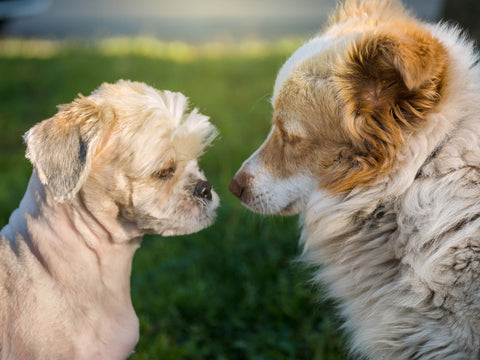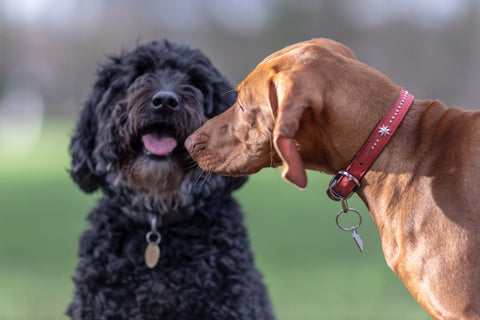Now you can understand your dog's feelings! Learn about calming signals (dog language)!

We will explain in detail the calming signals that will help you communicate with your dog better and lead a more comfortable and good lifestyle if you understand the meaning of dog behavior that occurs when you live with a dog. .
<Table of contents>
- What is a calming signal?
- Types of calming signals
- The importance of learning calming signals
- To get closer to the ideal relationship with your dog
Do you know your dog's calming signals?

Calming signals are body language that dogs use to express emotions that they cannot express through words.
It was coined by Turid Lugas, an internationally renowned trainer who has dedicated her life to dogs, their behavior, and their well-being, and is so famous around the world that it is also known as dog language in Japan.
Calming signals have the meanings of "Calming" and "Signal" and are used to prevent something from happening, to avoid threats from humans or other dogs, and to respond to unpleasant stimuli such as anxiety, fear, and noise. It is used to calm reactions.
It is also used by dogs to calm themselves when they are stressed.
Furthermore, calming signals are used to let people and dogs around you know that you are not hostile, and are used to communicate in a friendly manner.
When you live with your dog, have you ever wondered what your dog is thinking or had a moment when you have doubts about its behavior?
Our dogs may have different emotions than we expect, such as when they behave around the house, when they interact with other dogs during walks or at the dog park, or when they interact with strangers outside of the family. You may be holding it.
In order to understand dogs more deeply, by knowing what calming signals are and how they are used, you will be able to communicate with your dog better than ever and make your life more enjoyable and comfortable. Masu.
Understand that calming signals are important communication for dogs.

Generally, they emit various signals using their bodies, faces, ears, tails, sounds, movements, facial expressions, etc.
For example, have you ever seen your dog suddenly turn sideways or turn away while playing with another dog and stop playing?
This is an attempt to calm down my overexcited feelings while playing.
Calming signals are often given at random moments, so you need to closely observe your dog to avoid missing them.
At first, you may not know or notice which behavior is a calming signal, but as you observe your dog, you will gradually become aware of it.
We can also learn the calming signals that dogs use, and by understanding their behavior, communication becomes much easier.
There are many situations in your life when you want to know what your dog is thinking, feeling, and feeling.
Let's check out what types of calming signals there are.
Types of dog calming signals

There are various types of calming signals, but this time we will introduce one from ``Welcome to the world of dog language! -Calming signals-'' written by Turid Lugas, who advocated calming signals.
2. turn away
5. walking slowly, slow movements
6. A posture that invites play (bowing posture)
7. sit down
8. face down
9. Yawn
Ten . smell
11 . cut in between
12 . wag the tail
These are dog behaviors that we often see in our daily lives, but each behavior has a meaning. I will explain each one in detail in the future, so please check it out.
Calming signals will help you understand not only your dog's calming signals, but also the calming signals of other dogs, which may help protect your dog.
Also, when your dog comes into contact with other dogs on various occasions, you may be able to help your dog by giving a calming signal.
Observe your dog in various situations to learn to recognize calming signals.
■At home

First, take some time to observe your dog.
Observe what your dog is doing whenever something happens, such as when someone is moving around the house or when you have guests over.
■With other dogs

When your dog comes into contact with other dogs while out for a walk or at the dog park, carefully observe what kind of behavior your dog does when it notices other dogs or is nearby.
■One by one

I think it would take a lot of time to understand all the calming signals, so I think it's a good idea to clearly understand the calming signals you want to know one by one.
It is also a good idea to concentrate on observing the calming signals that your dog often uses (licking around the mouth, yawning, etc.), and once your dog starts noticing them naturally, you can start learning other calming signals.
The importance of learning calming signals

The purpose of learning calming signals is that they are important in order to make communication with your dog easier and to improve your life with your dog.
By understanding calming signals, you can avoid conflicts with your dog and minimize the risk of raising a timid, anxious, aggressive or stressed dog. .
It can also reduce dangerous situations where a dog's self-protective instincts could result in a bite or injury.
Calming signals allow both owners and their dogs to live stress-free and comfortable lives.
To get closer to the ideal relationship with your dog

We want you to get one step closer to your ideal relationship by understanding your dog more deeply.
Every action your dog does has a meaning, and it depends on how well you understand whether it makes your dog feel bad or brings him joy.
If you try to force your dog to obey you by giving commands or by inflicting pain to make it obey, you will lose trust with your dog and make him feel afraid.
Whether your dog becomes threatening towards other dogs or people or whether he feels at ease with them will depend on whether you and your dog understand each other in your daily life.
If your dog learns to be afraid of you, it will activate its defensive instincts, causing it to hurt other dogs or people, or it will live in fear and discomfort for the rest of its life.
Dogs are naturally conflict-resolving animals.
Only owners can guide their dogs to trust other dogs and people in a fun and friendly manner without stimulating their defensive instincts.
Turrid Lugas, who advocated this calming signal, says that if you listen to the dog's feelings, unpleasant feelings and pain are unnecessary, and it's up to the owner to remove them.
In addition, as a basic way to interact with dogs, you should not only bend your body when lowering your body, but also bend your knees and crouch down, touch them from below the chin, and avoid hugging them tightly. He says it's important not to create fear.
Learning calming signals, understanding your dog's feelings, feeding your dog what's good for them, and remembering that whether you can do all of these things for your dog depends on how you feel about your dog. Please.
Learn how to communicate with your dog, understand your dog's feelings, and use calming signals (dog language) without hurting your dog to have a comfortable and enjoyable pet life.









